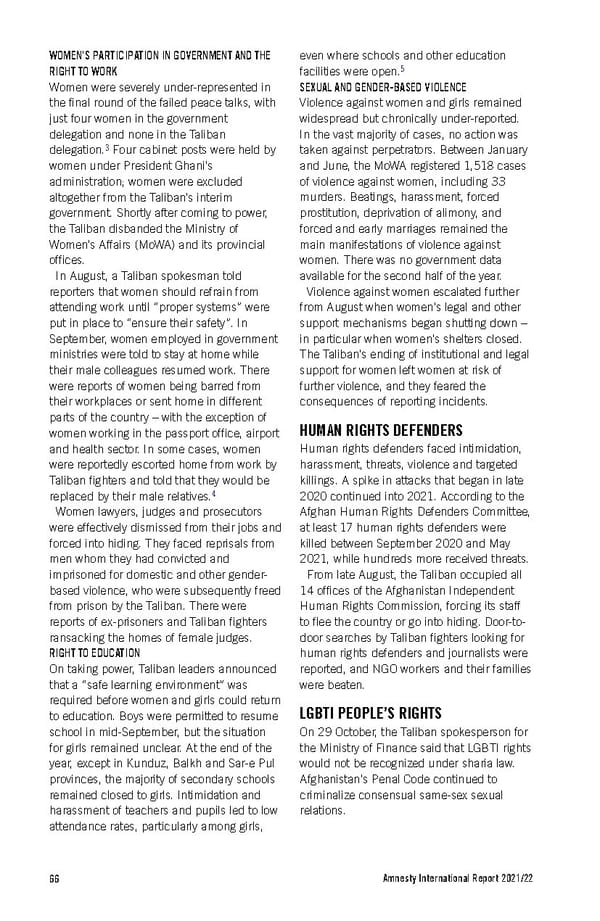WOMEN’S PARTICIPATION IN GOVERNMENT AND THE even where schools and other education 5 RIGHT TO WORK facilities were open. Women were severely under-represented in SEXUAL AND GENDER-BASED VIOLENCE the final round of the failed peace talks, with Violence against women and girls remained just four women in the government widespread but chronically under-reported. delegation and none in the Taliban In the vast majority of cases, no action was delegation.3 Four cabinet posts were held by taken against perpetrators. Between January women under President Ghani’s and June, the MoWA registered 1,518 cases administration; women were excluded of violence against women, including 33 altogether from the Taliban’s interim murders. Beatings, harassment, forced government. Shortly after coming to power, prostitution, deprivation of alimony, and the Taliban disbanded the Ministry of forced and early marriages remained the Women’s Affairs (MoWA) and its provincial main manifestations of violence against offices. women. There was no government data In August, a Taliban spokesman told available for the second half of the year. reporters that women should refrain from Violence against women escalated further attending work until “proper systems” were from August when women’s legal and other put in place to “ensure their safety”. In support mechanisms began shutting down – September, women employed in government in particular when women’s shelters closed. ministries were told to stay at home while The Taliban’s ending of institutional and legal their male colleagues resumed work. There support for women left women at risk of were reports of women being barred from further violence, and they feared the their workplaces or sent home in different consequences of reporting incidents. parts of the country – with the exception of HUMAN RIGHTS DEFENDERS women working in the passport office, airport and health sector. In some cases, women Human rights defenders faced intimidation, were reportedly escorted home from work by harassment, threats, violence and targeted Taliban fighters and told that they would be killings. A spike in attacks that began in late 4 replaced by their male relatives. 2020 continued into 2021. According to the Women lawyers, judges and prosecutors Afghan Human Rights Defenders Committee, were effectively dismissed from their jobs and at least 17 human rights defenders were forced into hiding. They faced reprisals from killed between September 2020 and May men whom they had convicted and 2021, while hundreds more received threats. imprisoned for domestic and other gender- From late August, the Taliban occupied all based violence, who were subsequently freed 14 offices of the Afghanistan Independent from prison by the Taliban. There were Human Rights Commission, forcing its staff reports of ex-prisoners and Taliban fighters to flee the country or go into hiding. Door-to- ransacking the homes of female judges. door searches by Taliban fighters looking for RIGHT TO EDUCATION human rights defenders and journalists were On taking power, Taliban leaders announced reported, and NGO workers and their families that a “safe learning environment” was were beaten. required before women and girls could return to education. Boys were permitted to resume LGBTI PEOPLE’S RIGHTS school in mid-September, but the situation On 29 October, the Taliban spokesperson for for girls remained unclear. At the end of the the Ministry of Finance said that LGBTI rights year, except in Kunduz, Balkh and Sar-e Pul would not be recognized under sharia law. provinces, the majority of secondary schools Afghanistan’s Penal Code continued to remained closed to girls. Intimidation and criminalize consensual same-sex sexual harassment of teachers and pupils led to low relations. attendance rates, particularly among girls, Amnesty International Report 2021/22 66
 Amnesty International Report 2021/22 Page 65 Page 67
Amnesty International Report 2021/22 Page 65 Page 67